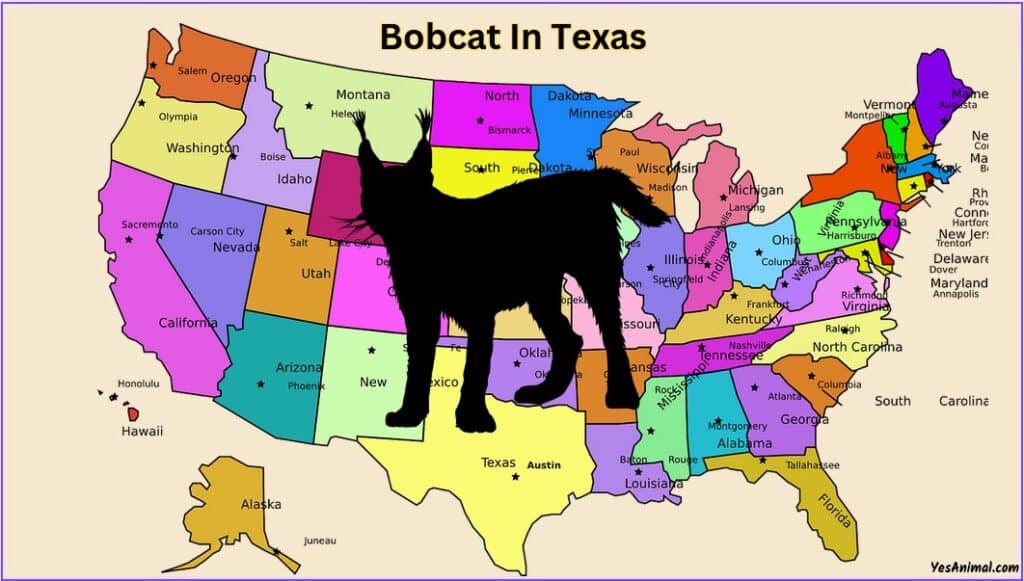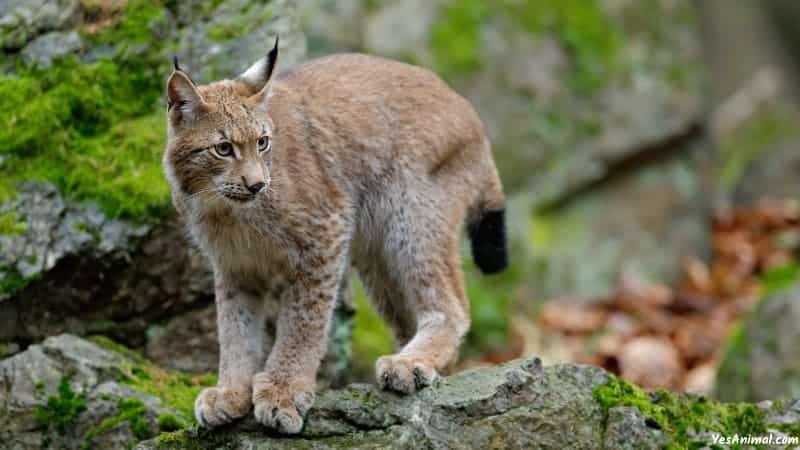Last Updated on September 14, 2023 by Amin Tawar

These creatures prowl silently through the dense forests of Texas at night to avoid human encounters. If you are not looking closely, you may easily mistake them for a domestic cat. Yes, we are talking about the bobcats, the medium-sized wildcats.
In addition to bobcats, the state is also known to house about 7 different types of wildcats out of which 3 are extinct. Out of the existing wildcats, bobcats are more common and found across the state.
Below I’ve explained everything you need to know about the Bobcat’s presence in Texas.
Are There Bobcats in Texas?
Yes, there are bobcats in Texas. In fact, compared to their counterparts in the wild cat family, bobcats are quite common in the state. As these creatures can live in various habitats, they thrive in Texas due to the presence of a range of landscapes like forests, and grasslands in the state.
As per biologists, there are two subspecies of bobcats in the state. The ones found in the west and northwest part are called the desert bobcats and the ones present over the rest of the state are called the Texas bobcat. It is however difficult to differentiate them as they are very similar.
These adaptive cats are skilled in hunting and predominantly feed on small animals like rodents, squirrels, and rabbits. Like other wild cats, bobcats are elusive and avoid human encounters. However, it’s not uncommon to spot them especially if you live in rural areas or wilderness areas with a dense forest cover.
Are There Bobcats in Houston?
Houston inhabits a range of wildlife which includes bobcats (Lynx rufus).
Houston is a large urban city and is the most populous city in Texas. It is however surrounded by suburban and rural areas which inhabit Bobcats. These areas have a variety of landscapes like parks, green spaces, and wooded places which are all good habitats for bobcats.
As bobcats are elusive, shy, and solitary, it is very rare to spot them within city limits. However, as bobcats migrate for prey and mating, they might venture occasionally into suburban areas on the outskirts of the city.
What Part of Texas Has Bobcats?

Bobcats are highly adaptive creatures and hence are found across the state of Texas. Their preferred habitats include forests, grasslands, brushlands, etc, which are all found in Texas.
While they mostly are found in suburbs and rural areas, due to their agile nature they are also sometimes spotted in urban areas with a dense forest cover.
Having said all this, bobcats are however predominantly found living in the eastern, central, and southern regions of Texas. Here there is a greater abundance of suitable habitats with dense forest cover.
These regions include Piney Woods, Edwards Plateau, South Texas Plains, and coastal areas of the state. Some of the counties with Bobcat’s presence include Harris County, Travis County, Bexar Country, and Dallas County.
Although these wildcats are found almost in every county, they are most common in South Texas Brush Country.
Also Check Our Guide On Bobcats In US
What is Texas Bobcat Size?
While bobcat size changes with respect to habitat and other factors, Texas bobcats are of similar size to their counterpart subspecies in the state.
In general, adult Texas bobcats weigh between 15 to 30 pounds and male is larger than female. They stand at about 2 to 3 feet tall with a tail of 4 to 7 inches in length. Their fur is of cream buff shade with gray and brown tones with spots.
Texas bobcats have excellent eyesight. This not only keeps them safe from their predator like mountain lions but also helps them hunt their prey.
Are Bobcats Rare in Texas?
No, bobcats are not rare in Texas. In fact, these wild cats are thriving in the state as compared to their counterparts in the family including mountain lions, cougars, etc.
Their ability to adapt to their surroundings helps them survive any type of habitat. Currently, Texas has a stable and healthy population of Bobcats.
Although these wild cats are shy and elusive and are not found in cities. They are often sighted in the suburban and rural areas on the outskirts of cities where there is a low-density of human population.
Additionally, wildlife agencies closely monitor and track the bobcat population across the state. These agile creatures also play the significant role of predators in keeping the ecosystem stable.
What Is the Bobcat of Central Texas?
Texas bobcats are one of the two subspecies of bobcats found in Texas. They inhabit central Texas among other parts as bobcats are well adapted to the diverse habitats. These bobcats with their tufted ears bobbed tails and mottled coats are similar in characteristics and behavior to bobcats in other parts of the state.
Are Texas Bobcats Aggressive?
No, Texas bobcats are not aggressive. Although they are almost double in size of a domestic cat, these cautious wildcats are shy and avoid human interactions. They are generally solitary and elusive and are more likely to retreat or hide rather than behave aggressively.
However, like other wild animals, bobcats can become defensive and aggressive when they are threatened or cornered. When they do perceive a threat, these wildcats would exhibit growling, hissing, and lunging to show their discomfort. During such situations, it is important to give space, back away and allow it to retreat to its habitat.
Therefore, be it a big cat or a medium cat, it is important to respect its space and observe them from a distance for both our and their safety.
Also Check Our Guide On Bobcats In Ohio
Can You Own & Kill A Bobcat in Texas?
No, you cannot own or kill a bobcat in Texas. Texas Parks and Wildlife Department governs and manages the regulations regarding bobcats.
As bobcats are classified as non-game animals, there is no closed hunting season for these wild cats. However, with valid permits and licenses, bobcats may be captured, possessed, or controlled.
These exceptions are mostly applicable to trappers, landowners dealing with depredation issued due to these cats, or for educational or research purposes.
However, any killings must be reported immediately to Texas Parks and Wildlife Department to support in tracking and management of the bobcat population.
Legalities aside, bobcats are wild animals and therefore require exceptional care. Additionally, they may prey on domestic animals, and pets and can carry various diseases.
Therefore, instead of owning a bobcat as a pet, just observe these creatures in the wild or visit any wildlife sanctuaries or national parks to observe them in their natural habitat. This way both you and the bobcat can be safe.
Conclusion
And that was everything you need to know about the Bobcats in Texas. I hope this article was informative and your queries were answered.
Thank You For Reading!
Our Goto Source For This Guide